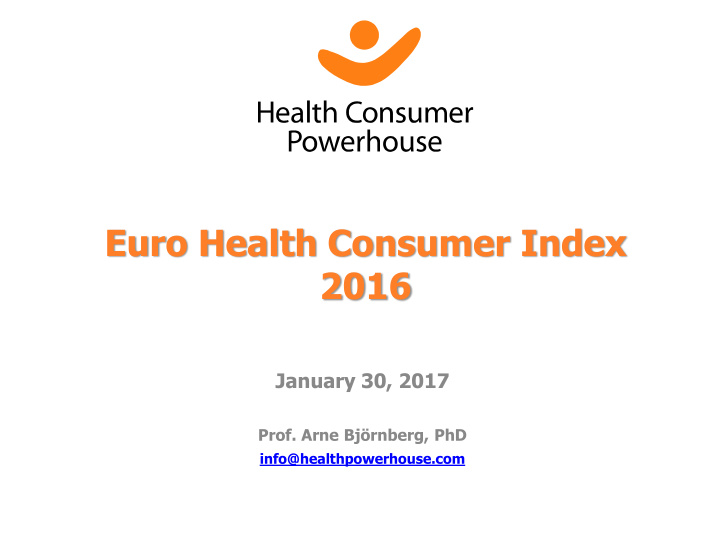



Euro Health Consumer Index 2016 January 30, 2017 Prof. Arne Björnberg, PhD info@healthpowerhouse.com
About Health Consumer Powerhouse Comparing healthcare systems performance in 35 countries from a consumer/patient view. Since 2004, more than 40 index editions, available for free. Index projects financed through unconditional development grants, similar to medical faculty sponsored research. Europe Euro Health Consumer Index 2005, 2006, 2007, 2008, 2009, 2012, 2013, 2014, 2015 Euro Consumer Heart Index 2008, 2016-2017 Euro Diabetes Care Index 2008, 2014 Euro HIV Index 2009 Euro Patient Empowerment Index 2009 Nordic COPD Index 2010 Tobacco Harm Prevention Index 2011 Euro Headache Index 2011 Euro Hepatitis Index 2012 Euro Vision Scorecard 2013 Euro Pancreatic Cancer Index 2014 Sweden, others Health Consumer Index Sweden 2004, 2005, 2006 Diabetes Care Index Sweden 2006, 2007, 2008 Breast Cancer Index Sweden 2006 Vaccination Index Sweden 2007, 2008 Renal Care Index Sweden 2007, 2008 Smoke Cessation Index Sweden 2008 COPD Index Sweden 2009, Nordic 2010 Advanced Home Care Index Sweden 2010 Euro-Canada Health Consumer Index Canada 2008, 2009 Provincial Health Consumer Index Canada 2008, 2009, 2010 All Hospitals Index Sweden 2011
EHCI 2016 sub-disciplines Sub-discipline Weight (points out Doing well of 1000 for full score) Norway Patient rights, information 125 and e-Health Belgium, FYR Macedonia, Waiting times / Access 225 Switzerland Finland, Iceland, Germany, Outcomes 300 Netherlands, Norway, Switzerland Netherlands, Sweden Range & Reach of 125 services provided Norway Prevention 125 France, Germany, Ireland, Pharmaceuticals 100 Netherlands, Switzerland deployment A total of 48 indicators in six sub-disciplines And we have really tried to be inventive and make the Index more challenging, but there is no stopping The Netherlands!
Total scores in EHCI 2016 Green; countries scoring >800 points!
EHCI 2016 Important trends Treatment results in European healthcare keep improving essentially everywhere! Some indicators in the EHCI are becoming less distinctive ; ” too many Green scores”! EHCI 2017 will be overhauled, to become more challenging – less opportunity for longitudinal analysis! Savings on pharmaceuticals the most obvious effect of austerity Some patterns remarkably stable over time – waiting lists a mental condition? Accessibility has no correlation with finances, mainly because operating a healthcare system without waiting lists is inherently cheaper than having them
What can Europe learn from The Netherlands? ”Chaos” systems, where patients can choose where to seek care, do better than ”planned” systems; but ” chaos ” needs to be managed, and the NL does that very well! Choice and competition! (and remember that this has to have a ” grandfather ” function managing the system!)
So what could be the improvement potential for the European Champions? The Netherlands tops 3 sub-disciplines, and has really no weak points historic waiting time problems largely rectified
The Netherlands used to have significantly higher healthcare costs than comparable countries.
Other countries, particularly Germany and Sweden, have caught up!
Macedonia no longer winning only because limited finances! Estonia, Czech Republic, Serbia, (and Albania; could be an effect of the model) seem to give good value for money in healthcare!
” Structural Antiquity ” Index for healthcare systems Costs are not model -dependent – they depend on how a country manages and operates its healthcare services!
Savings potential if Dutch healthcare would approach the in/out-patient mix of Sweden EUR 8 billion /year? At the Future Health Summit, Dublin 2016, a Dutch goverment representative, referring to the EHCI, presented that the Netherlands is aiming at a cost reduction of EUR 12 billion through care restructuring!
Europe is divided into ” waiting list territory ” (Red) and ”non -waiting list territory ” (Green). This is independent of Accessibility in EHCI 2015 GDP/capita. Has improved since 2013!
Accessibility not really related to number of doctors!
Money does not necessarily buy better access to healthcare! BE CH MK CZ SE PL UK IE
Almost all countries show a positive trend over time – exceptions are Sweden and Romania.
Treatment results keep improving! In 12 European countries, heart disease is no longer the biggest cause of death!
Treatment results keep improving! In EHCI 2006, there were 9 Green scores, using the same cut-offs
And yes; wealthy countries have better Outcomes – but not all! Portugal, Slovenia and the U.K. move into Green for the first time in EHCI.
Money does buy better Treatment Results R = +83 %
Sometimes money buys worse healthcare Clinic dialysis is over-remunerated, and home dialysis is under-remunerated?
An example of a LAP Indicator ; ” Level of Attention to the Problem”. Wealthy countries can afford admitting patients on weaker indications, but there are deviations! Greek hospitals have press gangs roaming city streets?
Greeks can somehow carry on spending on drugs and hospital admissions There is no evidence which supports that public health benefits from dispensing drugs to deceased patients
Restrictivity with new drugs
Women should have the right to abortion, but abortion as a contraceptive is not a good idea! CEE abortion rates on their way down.
”Bismarck Beats Beveridge ” Bismarck systems dominate the top of EHCI ranking Beveridge systems offer conflicts between loyalty to citizens and loyalty to healthcare system/organisation (“politician home town job preservation”) lack of business acumen in Beveridge systems; efficiency gains and cutbacks frequently not differentiated! small Beveridge systems (the Nordic countries) can compete 100’s of thousands of professionals take better decisions and drive development better than central bodies The essential characteristic of Bismarck systems is the separation of financing decisions and operative decisions – finansors should not micro-manage hospitals”
THANK YOU - SEE IT ALL ON www.healthpowerhouse.com
Recommend
More recommend